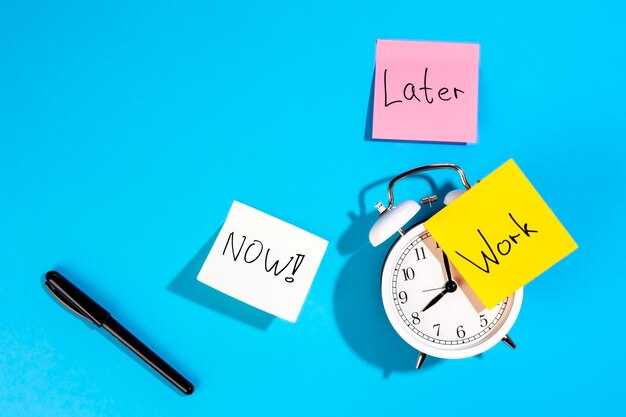Set a 25-minute timer, put the phone in another room, open only one file and commit to one measurable micro-goal (write 100 words, complete one subtask). If resistance persists for more than 2 minutes, apply the 2-minute rule: do any usable two-minute step to generate momentum. Repeat that block three times; this simple protocol makes it very likely to sustain attention and convert a stalled start into progress.
Task management requires explicit mapping: list every item on a spectrum from 5 minutes to 5 hours, label three daily priorities, and batch similar tasks into focused afternoons. For household duties, assign fixed slots (e.g., laundry at 5pm) so house work does not hijack cognitive resources. Treat batching as a short program of 60–90 minutes per domain to reduce context switching and decision friction.
Address emotional drivers directly: chronic avoidance often masks fear of mistakes or low self-efficacy. Keep a one-week “mistake log”: note the anticipated error, the actual outcome, and whether someone provided feedback; this practice helps realize that most errors are minor and recoverable. Increase tolerance for imperfect output by intentionally producing draft versions and scheduling review slots rather than aiming for finality on first pass.
If avoidance is persistent, consult a psychologist and consider a focused CBT-based program (commonly 8–12 sessions) to reframe unhelpful beliefs and build stepwise exposure to feared tasks. Use brief experiments: tell myself aloud “two minutes only,” test the duration, then scale up; this reduces the emotional intensity that triggers resistance and shows measurable gains.
Measure changes: log start and finish times for each block for 14 days, calculate the percentage of afternoons with at least three focused blocks, and adjust the plan if completion rate stays below 40%. When progress stalls, look for environmental tweaks (move to another room in the house), ask someone for an accountability check-in, and make small structural changes to daily management so focused effort can be repeated and sustained.
Identify the exact trigger that makes you put tasks off
Log each avoidance episode for 14 days: record clock time, preceding activity, mood (1–10), task category, exact delay in minutes, location, presence of phone or browser tabs and a short quote of self-talk (e.g., saying “not ready”). Define an episode as delay >10 minutes or moving the task past its scheduled block; after 14 days compute frequency by time slot and task type and flag any trigger that accounts for ≥30% of episodes – this produces a concrete dataset rather than impressions.
If the dataset shows unclear task scope: frame the assignment into three micro-steps under 15 minutes each, add a 10-minute sound cue to begin the first micro-step and mark completion after each step. If anxiety, perfectionism or suspected executive-function disorder appears: run 15-minute exposure blocks paired with brief accountability checks; university counseling or an online CBT program can reduce avoidance signals and has produced increased on-task time in controlled pilots. If boredom and low reward valuation surface: apply a Pomodoro variant (25/5) with a tiny immediate reward after each Pomodoro to change reinforcement patterns.
Run a one-variable experiment for seven days: establish a baseline completion rate (percent of planned micro-steps finished). Change only one variable – remove phone during blocks, shift work to a specific hour, or add a five-minute warmup – and measure the new completion rate. Aim for an absolute improvement of 15–20 percentage points; log mistakes, interruptions and elapsed time so youve objective evidence to choose interventions that really work. Recruit an accountability partner whos available for a brief nightly check; compare results with peoples aggregated reports from the same online program or campus group when possible.
For executive management deficits adopt simple external supports: calendar blocks under 30 minutes, pre-laid materials, alarm-based transitions and a visible progress frame (checkboxes or a single progress bar). Avoid all-or-nothing rules; celebrate the smallest completion after each block to build momentum. An author of a time-management program recommends treating the first two minutes of any block as permission to fail, which helps overcome initiation resistance without increasing long-term errors or task abandonment.
Check if avoidance is fear of failure – a quick self-test
Recommendation: Run this five-point self-test in 15–20 minutes; score 3 or higher indicates avoidance likely driven by fear of failure and requires repair actions today.
1) Bias check – list the first three excuses given when delaying tasks and mark whether each excuse mentions standards, judgment, or outcome; presence of outcome-focused language counts 1. 2) Estimates audit – compare initial time estimates for several recent items (use records from the past years); if estimates have been repeatedly inflated or deflated by more than 50% the pattern has been present and counts 1. 3) Chunk test – pick one task that has been avoided until deadline, break it into smaller steps, add the first twenty-minute interval to todoist starting immediately; if cant start the first block, mark 1. 4) Emotional intensity – when thinking about a task, note if the first reaction is “harder than worth,” “never good enough,” or fear of criticism; rate 0–3 and convert 2+ into 1 point. 5) Goals alignment – list top three goals and check whether avoided tasks are aligned; if tasks map to goals but still avoided, that mismatch is a direct cause and scores 1.
Scoring and repair: total the points; 0–1 suggests other causes, 2 ambiguous, 3–5 indicates fear-driven avoidance. Repair steps: schedule daily twenty-minute sprints in todoist for three consecutive days, reduce first-block estimates by half, assign one accountability check (peer review or timed demo) within 48 hours, record excuses to expose bias, and implement one concrete changes that lead to measurable progress. For individuals struggling with recurring patterns over years, please stay consistent for at least three weeks before reassessing; never drop the tiny-start rule until progress has been seen.
Confirm task ambiguity – use a three-question clarity check

Use this three-question clarity check; answer all three before adding any task to a schedule.
-
What is the exact next action?
Write a single, observable step: verb + deliverable + timebox. Example templates: “Draft 300-word intro by 10:00 AM Thursday” or “Call Maria to confirm venue, max 10 minutes.” If the line item cannot be executed without additional decisions, it is ambiguous. Rewrite into a small concrete step until it is real and executable.
-
Who owns it and what counts as done?
Specify an individual owner and a sound acceptance criterion: Owner: name; Done when: measurable outcome (file uploaded, confirmation received, test passed). Responsibility must be explicit – avoid “team” without a named person. A clear role reduces aversive uncertainty and trains accountability between stakeholders.
-
When will it happen and what blocks it?
Place a calendar slot or a Todoist due + time; list known blockers and required inputs. If the task competes with higher-priority items, schedule a 15–60 minute block rather than leaving it open. For cross-border logistics (trains, multiple countries), include timezone, currency, and passport checks as blockers so the task is not prone to last-minute friction.
- If any answer is missing, split the task into smaller units and repeat the check until all three are satisfied.
- For tasks under 15 minutes, either do them immediately or schedule the same day; small wins often worked to break avoidance loops in experimental research across countries.
- Tag tasks in Todoist with “clarity-check” and assign responsibility and a due time; use reminders for items that feel aversive so they land as calendar events rather than vague intentions.
Practical thresholds: usually one sentence for the next action, one named owner, and a timebox in minutes. These criteria separate vague ideas from actionable items and lower the strong emotional barrier that makes individuals prone to delay. A real, verywell specified task feels sound and easier to commit to; if it still feels fuzzy, rewrite until concrete.
Detect energy dips versus decision fatigue – a simple morning checklist
Conduct a 10-minute morning energy audit: record sleep hours, last meal time, hydration (ml), caffeine intake (mg), subjective energy 1–5, and mark whether appetite or yawning occurred; if energy ≤2, postpone novel strategic choices.
Distinguish signs: an energy dip shows physical markers (yawning, heavy eyelids, hunger) and often arrives 60–90 minutes after waking or post-lunch; decision fatigue appears as reduced patience, small errors after 60–120 minutes of active choices and an increasing tendency to avoid or default to habit.
Checklist actions (use a timer): 1) 3 minutes – scan inbox for urgent items and archive what can wait; 2) 5 minutes – capture ambiguous tasks into Todoist with a single clear next action; 3) 7–15 minutes – perform one engaging, low-cognitive task (email template, filing) to buy relief if brain energy is low; 4) if facing an emotional decision, wait 30 minutes and re-evaluate.
Decision rules: if task demands >15 minutes of novel thinking and audit energy ≤3, delegate to a team member, split into 10-minute chunks, or schedule for a peak-energy window; putting routine microtasks into Todoist trains the brain to treat decisions as deferred, reducing mental clutter.
Evidence: Professor Roy Baumeister’s work and subsequent reviews show sustained choice-making reduces self-control capacity in lab settings; broadly, operational costs and error rates rise when high-cognitive work is attempted during dips, creating measurable damage to output quality and time costs.
Practical examples: mark a calendar block labeled “peak work” for two 90-minute sessions; attach task contents and the single next action to each block so future-self can resume without ambiguity; when waiting for a meeting, keep a 5‑minute checklist to prevent slipping into low-value browsing.
Run a 7-day log (minutes spent on decisions, # of delegations, subjective energy). Review weekly with a peer or team to spot patterns; this small audit puts structure on emotional variance, keeps the brain aligned with real capacity, and makes relief from decision overload measurable and worth the effort.
Spot perfectionism habits – one change to reduce stalls

Set a 15-minute “good-enough” drafting timer and publish whatever appears at the bell; mark further edits as “round two” to break perfectionism habits immediately.
Controlled trials and survey evidence referenced in productivity books show that limiting initial editing sessions reduces total time to completion and raises output frequency. Individuals chronically prone to polishingfinal drafts are associated with delaying launches, and that pattern can be self-defeating: extra polishing often makes final delivery harder and lowers real-world impact.
Look for measurable signals: sections that attract more than three micro-edits within an hour, tasks delayed beyond the planned release date, or pieces still looking unlaunched after seven days. These behaviors seem to lead others into unnecessary cycles; talking with a colleague usually helps to realize which changes actually improve accuracy versus those that merely make something pretty.
Practical protocol to crack the cycle: define one “accuracy” checklist (facts verified, citations present, key metric readable), limit polishing to a single 30-minute window per deliverable, ask a peer to flag edits that cause scope creep, and log time spent vs. impact for two weeks. Small metric targets (reduce editing time by 30%, cut delay days in half) give concrete goals and make the cause-and-effect impacts visible rather than abstract.
10 Tactics to stop procrastinating – actions to take today
Schedule a protected 25-minute focus block on the calendar at the next available slot and treat it as a non-negotiable meeting; set a 5-minute break timer to follow.
- Time-box: run a 25/5 Pomodoro, pick one top to-do for the session, log start/end timestamps, then repeat until three sessions complete.
- Two-minute rule: any subtask ≤120 seconds gets done immediately; sometimes those quick wins remove the mental pile of excuses and increase momentum.
- Daily five: restrict the morning list to five items, mark which are mine, rank by ROI and effort, because small wins matter more than long, unfocused attempts.
- Implementation intentions: write explicit “If X then Y” lines before launching a task; this primes self-control and reduces friction when a harder step appears.
- Remove friction: close three distracting apps, mute notifications for 90 minutes – this lets uninterrupted focus accumulate and makes it easier to find flow.
- External accountability: book a 15-minute check-in with a peer; author david reports public deadlines raise completion rates – ask the peer to state their deadline and practice listening to progress.
- Visible cost: commit a small penalty (eg, $10) if a task is still waiting after 48 hours; if task wasnt completed apply the cost automatically to raise the behavioral price of waiting.
- Emotion labeling: pause 10 seconds, name the dominant thought and the emotion aloud; naming emotions reduces interference from feelings and limits excuses rooted in anxiety.
- Micro-goals: split projects into five measurable substeps, estimate effort for each, imagine the finished deliverable and record when a step feels harder than estimated to recalibrate timing.
- Weekly metrics: run a last-Sunday review of recent time logs, calculate completion rate for these tasks, note what was talked about in check-ins, what wasnt being tracked, and adjust incoming list including certain deadlines mentioned in meetings.
Tactics 1–2: Break work into 10-minute chunks and define the immediate physical next step
Set a 10-minute timer and execute one immediate physical step: open the project file, place a pen on the notebook, or type a working title. Treat that single thing as the goal for the block; completing the smallest, fairly simple action helps overcome the internal resistance that often keeps tasks waiting. If at least two blocks are possible, chain them back-to-back.
Psychological evidence and observed behaviors suggest a concrete stimulus within 10 minutes triggers action faster than broad planning; many people procrastinating report months or years pass with the same plan intact. Examples: a study routine replaced by watching videos across an entire weekend, or a work item that gets delayed for half a year. When the mind feels insecure or lazy about a task, a short timer reduces the waiting that happens before beginning.
Protocol: list three immediate physical next steps and label the types of action by setup time (open folder, highlight paragraph, write two sentences). Set the timer to 10:00, disable notifications, and avoid social feeds for the first half of the block; allow a very brief social check only after the first 5 minutes if it prevents derailment. If motivation does swim away, apply one more block to push momentum; small, consistent changes compound.
Measure progress: mark each completed 10-minute block and record the tangible worth of the outcome (one paragraph, one fixed bug). Over a week, five blocks per day amount to about 250 minutes of focused work; that gets more done than waiting for a perfect chance and suggests which behaviors to reinforce or replace. Use a social accountability partner for short check-ins to raise the perceived push needed to overcome insecure tendencies.
Tactics 3–4: Use a focused time block with a consistent start ritual
Begin each focused block with a precise 90-second entry ritual: five deep breaths (30 seconds), two shoulder rolls (20 seconds), a 10-second desk check to remove distractions, set a visible countdown for exactly twenty minutes, then write one measurable micro-goal on a sticky note. This sequence converts initial resistance into a repeatable action and lowers emotional friction for doing work.
| Step | Tempo | Purpose / Metric |
|---|---|---|
| Breathing | 30 seconds | Calm state; rate emotional score 1–5 |
| Stretch / roll | 20 seconds | Release tension; reduction in fidgeting |
| Desk check / phone away | 10 seconds | Remove visual cues; immediate distraction count = 0 |
| Set timer + micro-goal | 30 seconds | Exact twenty-minute target; write target and expected output |
After each block record three data points: items completed, perceived effort (scale 1–5), and emotional state. Small data entries taken immediately create objective progress logs; four twenty-minute blocks (80 minutes) with this ritual typically produce clearer output than a single unfocused two-hour session, despite initial skepticism.
Clinic reports and academic studies of studying routines often show measurable gains when a consistent entry ritual is used: common ranges in those reports sit between 10% and 30% improvement in productivity metrics. The distinction between ritual length and adherence matters – rituals under 90 seconds preserve compliance while longer rituals cause drop-off in real-world samples.
If the ritual seems boring or ritualized, make small changes: swap breaths for a quick walk around the room, add a tactile cue (coin or rubber band), or change the micro-goal format. For someone dealing with strong emotional concerns about beginning, instruct them to name the concern for ten seconds, write it down, then proceed. Putting a visible log with the person’s name or attaching the session to a partner who shares accountability increases commitment and reach.
Treat progress as a points game: assign 1 point per completed micro-goal and track streaks. The distinction between planning and doing becomes visible when completed-item counts replace vague time estimates. Attach your name to the session log, review weekly progress, and iterate rituals based on what the data states about effort, mood, and output during studying.


 Why You Procrastinate — 10 Proven Tactics to Stop Now">
Why You Procrastinate — 10 Proven Tactics to Stop Now">

 He Said Another Woman Is More Attractive Than Me – How to Cope">
He Said Another Woman Is More Attractive Than Me – How to Cope">
 19 Reasons Why He Isn’t Texting You Back — What to Do Next">
19 Reasons Why He Isn’t Texting You Back — What to Do Next">
 12 Must-Have Qualities to Look for in a Long-Term Partner">
12 Must-Have Qualities to Look for in a Long-Term Partner">
 How to Tell If Your Feelings Are Unrequited – Expert Insight & Clear Signs">
How to Tell If Your Feelings Are Unrequited – Expert Insight & Clear Signs">
 How to Make a Guy Fall in Love with You – 12 Proven Tips">
How to Make a Guy Fall in Love with You – 12 Proven Tips">
 No Spark with a Nice Man Interested in You? How to Decide & Act">
No Spark with a Nice Man Interested in You? How to Decide & Act">
 Never Judge a Woman by Her Appearance – Here’s Why">
Never Judge a Woman by Her Appearance – Here’s Why">
 Too Many Goals, Too Little Time? How to Focus Your Attention">
Too Many Goals, Too Little Time? How to Focus Your Attention">
 7 Uncomfortable Reasons You End Up in Toxic Relationships">
7 Uncomfortable Reasons You End Up in Toxic Relationships">
 3 Stages of a New Relationship – How to Handle Changes — Laura Smilski">
3 Stages of a New Relationship – How to Handle Changes — Laura Smilski">